The golden dome of this vast building appears suspended from heaven. It has withstood quakes, conquest, and crusades.
Isidore of Miletus and Anthemius of Tralles (architects), Hagia Sophia, Istanbul, 532–37. Speakers: Dr. Beth Harris and Dr. Steven Zucker
[0:00] [music]
Dr. Steven Zucker: [0:03] There are a handful of buildings throughout history that have changed the way we see architecture.
Dr. Beth Harris: [0:10] We’re standing in one of them. We’re in Hagia Sophia in Istanbul, what was once Constantinople.
Dr. Zucker: [0:18] And before that was Byzantium.
Dr. Harris: [0:20] First it was a Greek city, then part of the Roman Empire, and then Constantine decided to found a city here.
Dr. Zucker: [0:27] Which he called the New Rome, and which came to be known as Constantinople.
Dr. Harris: [0:31] Or the city of Constantine. That happened right at the time that Constantine was recognizing Christianity. By the end of that century, Christianity would become the official religion of the Roman Empire.
Dr. Zucker: [0:43] The emperor had his palace close by, and that was the reason that the most important church was built here. Now, the church that we’re standing in is not that original church. That burned down.
Dr. Harris: [0:54] And so did the next church.
Dr. Zucker: [0:55] They were actually burned during riots. The most famous riot took place in the 6th century, and it’s called the Nika Riot.
Dr. Harris: [1:02] Against the emperor of the time, Justinian, and Justinian was the patron of this church.
Dr. Zucker: [1:08] This church was a way of putting to work a lot of people in the city that might otherwise riot, but it was also a way for him to express his power across the empire.
Dr. Harris: [1:17] This was one of many churches that Justinian built. This building, though, is the centerpiece of that building program.
Dr. Zucker: [1:23] It’s unbelievable. We’re standing in this mountain of a building. In fact, to use that geologic term is appropriate. One author said that standing here where we are in the sanctuary was like standing at the bottom of an enormous canyon.
[1:42] Now, when this was built in the 6th century, it was absolutely unique in the world, not only for its scale, not only for its ambition, but also for its design.
Dr. Harris: [1:51] Justinian hired two theoreticians, two scholars who were well-versed in geometry and mathematical theory and physics, to think about how to vault this space. The two churches that were here before had wooden roofs.
Dr. Zucker: [2:06] Those were basic basilica structures, a kind of architecture that the ancient Romans were very comfortable with. We see that kind of architecture throughout the Roman Empire, and so it would’ve been very familiar to the Roman emperors Constantine and Justinian.
Dr. Harris: [2:18] Justinian asked his architects to do something different, and instead of building a traditional basilica, he had them build something that unified a centrally planned space with a basilica space.
[2:32] So, [a] basilica has a longitudinal format and a centrally planned space is based more on a circle.
Dr. Zucker: [2:38] Let’s talk about the basic geometries here. We have a dome that is phenomenally high. If you think about how the Romans handled domes, and they did build very large domed structures, think about the Pantheon in Rome. But in that case, you have a round dome sitting directly on a round barrel.
[2:56] This building is doing something much different. This dome is on a square. How in the world do you put the base of a round dome onto a square building?
Dr. Harris: [3:06] From that square base emerges two half-domes forming a rectangle of space that reminds us of a basilica.
Dr. Zucker: [3:14] So how have they done it? They’ve done it with something called a pendentive. If you look at the base of the dome, you see that it comes down on a series of four arches. The space between the four arches and the base of the dome, it’s kind of a triangle, but it’s curved.
[3:30] This miraculous thing happens. We know that dome must weigh an enormous amount, and yet it seems to come down on the slenderest of points.
Dr. Harris: [3:40] What the architects did was hide the enormous dome piers that are doing most of the work of supporting the weight and the thrust of that dome. Domes exert an enormous amount of pressure not only down, but also out.
[3:53] Part of the work of supporting the dome is also being done by the half-domes on either side, and on the east end, three smaller half-domes below that. This is the first time we see the dome on pendentives on this monumental scale.
Dr. Zucker: [4:08] And it was dangerous. It was incredibly ambitious but it didn’t work perfectly at first.
Dr. Harris: [4:13] No, there was an earthquake, part of the dome collapsed, and when it was rebuilt, it was redesigned. The dome that we see now is taller than the dome that was here originally.
Dr. Zucker: [4:22] By making it steeper, it allows some of the lateral force to be reduced so that the weight comes more vertically down, but the enormous thrust did destabilize the building. If you look carefully, you can actually see some columns and other structural elements have been pushed askew.
Dr. Harris: [4:38] So here we are talking about the engineering.
Dr. Zucker: [4:41] Well, this is an engineering marvel.
Dr. Harris: [4:43] But when you’re inside the space, you don’t think about that. You think about the complexity of the space. The mysteriousness of the space. The way that the walls dissolve into light. The mysticism of this space.
Dr. Zucker: [4:56] That’s what this was all about. In fact, an early chronicler said, “It seems as if the dome is suspended from heaven.” Part of the reason for that is — and this is just so incredibly ambitious — the architects pierced the base of the dome with 40 windows so that light streams in under the dome.
[5:15] You begin to lose the structural elements between the windows, and it seems almost to be continuous light.
Dr. Harris: [5:21] Light in Byzantine thinking is connected with ideas of perfection and the divine.
Dr. Zucker: [5:26] The windows create a rhythm that almost sets the dome in motion, and then all of that is resting on walls that are clad with marble that have rich veins and patterns that are all in motion. The floor is made of huge paving stones that seem as if it’s almost a pattern of waves.
Dr. Harris: [5:45] It lacks the solidity of ancient Roman architecture. Here we have a new Christian architecture for a new Christian Roman Empire.
Dr. Zucker: [5:54] For me, it is the perfect expression of the transformation of the physical into the spiritual. This is a building that was the spiritual heart of the empire.
Dr. Harris: [6:03] The emperor in the east, in the Byzantine Empire, which was a continuation of the Roman Empire but with vast amounts of territories that had been lost, that emperor was not just a political figure. He was also the head of the church.
[6:16] He appointed the patriarch, the man in charge of the church. This is very different than when we think about the pope in the western part of the empire.
Dr. Zucker: [6:26] And so when important rites took place in this church and the emperor and the patriarch came together, it was an expression of the unity of heaven and earth, of political power and spiritual power.
[6:37] We were talking about the way that this building is an expression of mystery. Its structural qualities are beautifully hidden. One of the things that distracts our eye from the structure is the surface decoration. All of those upper surfaces that are not colored stone were covered with gold mosaic.
Dr. Harris: [6:57] Mosaic that had decorative patterns.
Dr. Zucker: [6:59] Acanthus leaves, palm leaves. You could find crosses everywhere. What you couldn’t find was mosaics that showed figures. This was a period in Byzantine history that was leading up to what we call the iconoclasm, which was a point where there was a real crisis of images. When this church was built, it was a clear decision to avoid any kind of figural imagery.
Dr. Harris: [7:20] The decision might have been because of concerns around the commandment against creating graven images. But it also may have been to highlight the architecture instead of drawing your attention to Mary or Christ, but instead drawing your attention to an overall mystical effect of the space itself.
Dr. Zucker: [7:40] The color wasn’t just from the mosaics. All of this clear glass was originally colored. It was red, it was yellow, it was purple, it was blue, it was green. Then you have the surface of the marbles. Justinian paid an enormous amount of money to import marbles from across his empire.
[7:57] He’s brought the most beautiful, most elegant marbles that he could, and he’s embedded them in the walls, what we call revetment.
[8:05] His workmen were able to saw these pieces of marble crosswise and then open them up like leaves of a book, so that the patterns were actually mirrors creating these wonderful complex patterns, and so you have light streaming in the windows, gold mosaics, these colored marbles, all of which created this kaleidoscope of movement and energy.
Dr. Harris: [8:28] When the emperor stood with the patriarch of the Orthodox Church in this space, they wore gold, and purple, and silver.
Dr. Zucker: [8:36] And there were gems embedded in the thrones. There was an enormous screen that protected the sanctuary, and by some accounts, it was 35 feet high, completely covered in silver.
Dr. Harris: [8:49] You had the laity, normal people like us, standing in the aisles and the galleries above, and then only the patriarch, the priest, the clergy, and the emperor were allowed in this space, that as you said was screened, and so you had a mystery within this mysterious space. What a spectacle.
Dr. Zucker: [9:08] This building is almost 1,500 years old, so it’s gone through a lot of changes.
Dr. Harris: [9:12] Change is visible all around us. The floors are worn and uneven. Parts of the marble revetment are lost and have been painted instead. There’s clearly mosaics that date from different periods of time. Most obviously, there are Islamic inscriptions in the dome from when this building was made into a mosque.
Dr. Zucker: [9:32] The Byzantine Empire was ultimately conquered by the Ottoman Turks, who were Muslims, and this city, Constantinople, was the great treasure, and the great gem in that city was this church. When this city was conquered, one of the first things they did was transform it into a mosque.
Dr. Harris: [9:50] This functioned as a mosque until 1934, when it was secularized and made into a museum.
Dr. Zucker: [9:56] What we’ve lost mostly though is all of the original Christian furnishings.
Dr. Harris: [10:01] Not just furnishings but relics, reliquaries. This was a space that was filled with holy objects.
Dr. Zucker: [10:08] The reason for this is not when the Muslims invaded. The reason for this is when the Western European Christians invaded.
Dr. Harris: [10:16] Right, and that happened in 1204.
Dr. Zucker: [10:17] Instead of going to the Holy Land.
Dr. Harris: [10:19] To take back the Holy Land from the Muslims.
Dr. Zucker: [10:22] The Crusaders owed the Venetians a lot of money, which they couldn’t pay, and so they ended up sacking Constantinople instead.
Dr. Harris: [10:28] A lot of the great treasures that were once here are in Venice. They’re scattered through museums all over the world.
Dr. Zucker: [10:35] One can only imagine how rich this space must have looked when it was covered with gold and silver, when there were gems studding its most important furniture.
Dr. Harris: [10:45] When people were venerating the relics that were here and the icons that were here.
Dr. Zucker: [10:50] When this was the center of the empire.
[10:53] [music]
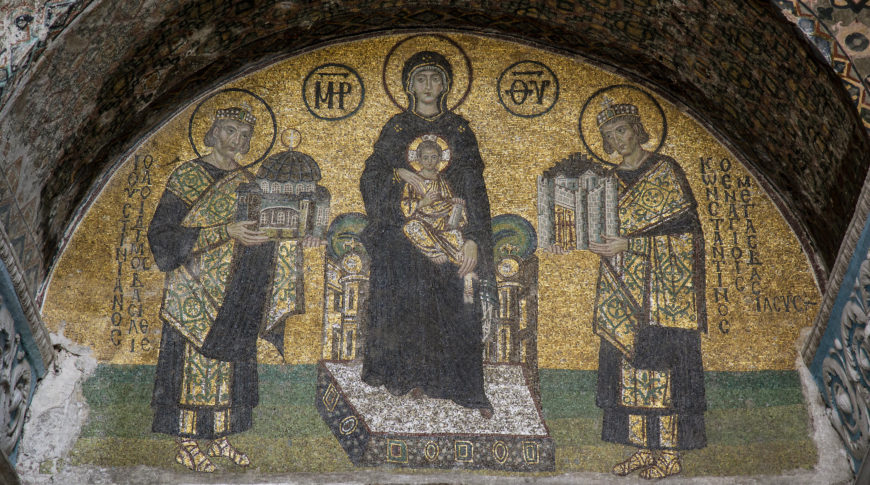
Constantine the Great presents the city (Constantinople) and Justinian the Great presents Hagia Sophia to the Virgin, mosaic, probably 10th Century, Southwestern Entrance, Hagia Sophia (photo: byzantologist, CC BY-NC-SA 2.0)
A symbol of Byzantium
The great church of the Byzantine capital Constantinople (Istanbul) took its current structural form under the direction of the Emperor Justinian I. The church was dedicated in 537, amid great ceremony and the pride of the emperor (who was sometimes said to have seen the completed building in a dream). The daring engineering feats of the building are well known. Numerous medieval travelers praise the size and embellishment of the church. Tales abound of miracles associated with the church. Hagia Sophia is the symbol of Byzantium in the same way that the Parthenon embodies Classical Greece or the Eiffel Tower typifies Paris.
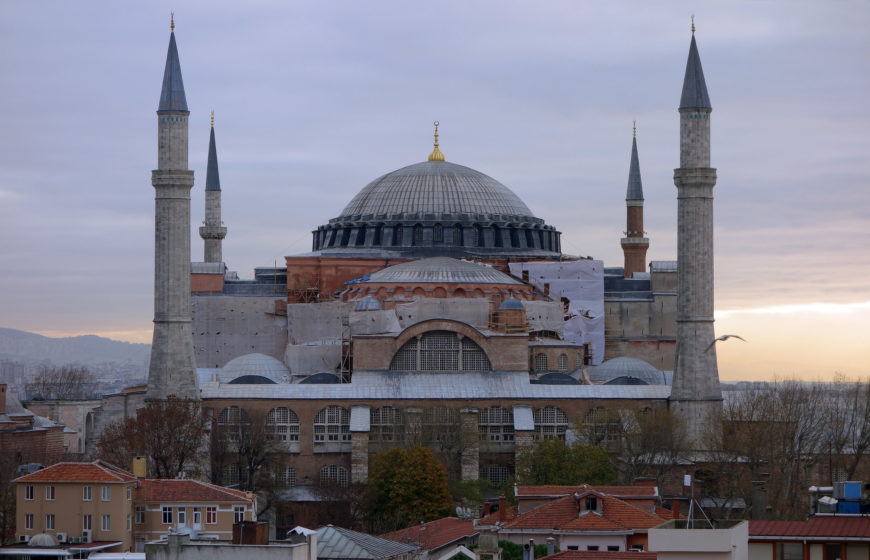
Isidore of Miletus & Anthemius of Tralles for Emperor Justinian, Hagia Sophia, Istanbul, 532–37 (photo: Steven Zucker, CC BY-NC-SA 2.0)
Each of those structures express values and beliefs: perfect proportion, industrial confidence, a unique spirituality. By overall impression and attention to detail, the builders of Hagia Sophia left the world a mystical building. The fabric of the building denies that it can stand by its construction alone. Hagia Sophia’s being seems to cry out for an other-worldly explanation of why it stands because much within the building seems dematerialized, an impression that must have been very real in the perception of the medieval faithful. The dematerialization can be seen in as small a detail as a column capital or in the building’s dominant feature, its dome.
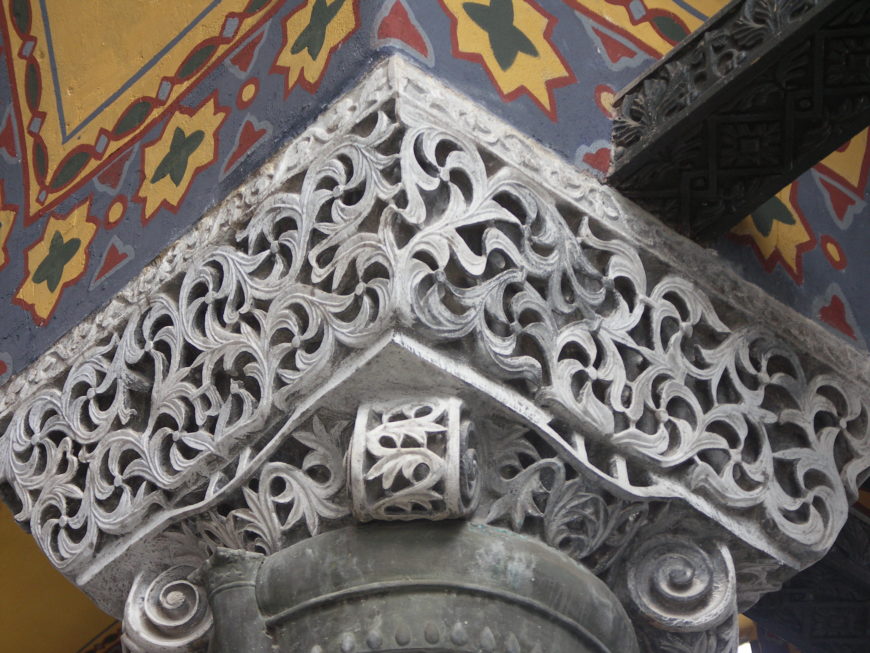
Basket Capital, Hagia Sophia (photo: William Allen, CC BY-NC-SA 2.0)
Let us start with a look at a column capital
The capital is a derivative of the Classical Ionic order via the variations of the Roman composite capital and Byzantine invention. Shrunken volutes appear at the corners decorative detailing runs the circuit of lower regions of the capital. The column capital does important work, providing transition from what it supports to the round column beneath. What we see here is decoration that makes the capital appear light, even insubstantial. The whole appears more as filigree work than as robust stone capable of supporting enormous weight to the column.
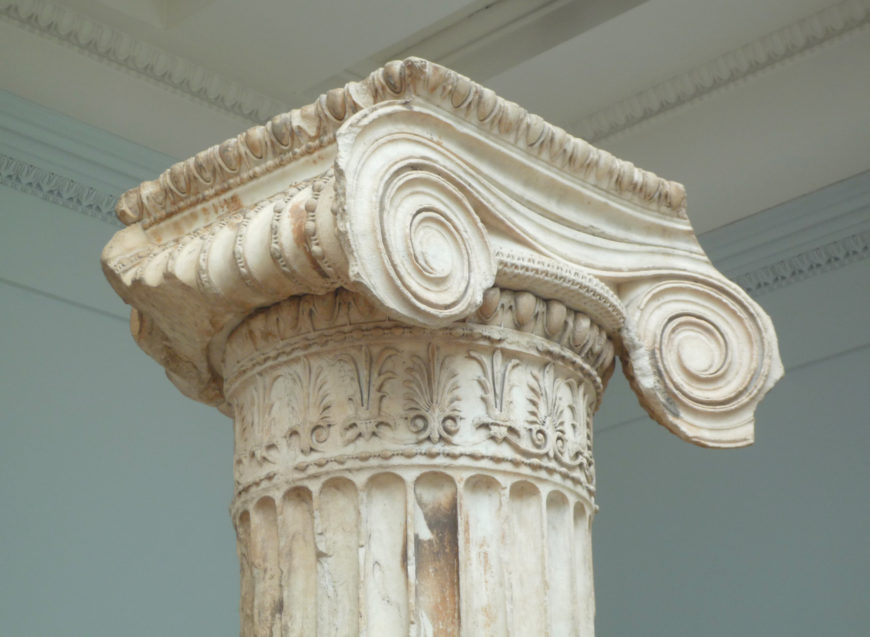
Ionic Capital, North Porch of the Erechtheion (Erechtheum), Acropolis, Athens, marble, 421–407 B.C.E., British Museum (photo: Steven Zucker CC:BY-NC-SA 2.0)
Compare the Hagia Sophia capital with a Classical Greek Ionic capital, this one from the Greek Erechtheum on the Acropolis, Athens. The capital has abundant decoration but the treatment does not diminish the work performed by the capital. The lines between the two spirals dip, suggesting the weight carried while the spirals seem to show a pent-up energy that pushes the capital up to meet the entablature, the weight it holds. The capital is a working member and its design expresses the working in an elegant way.
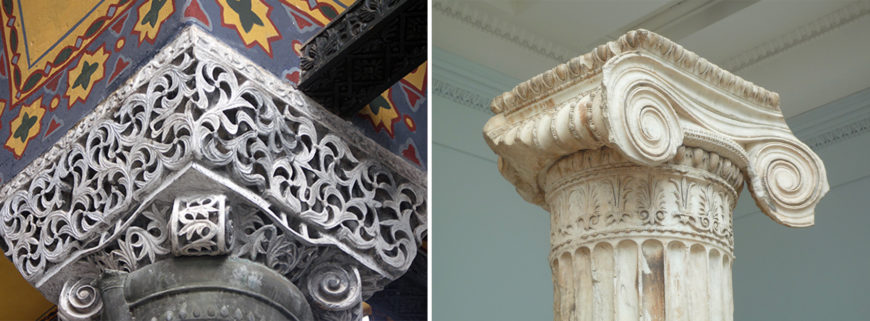
Left: Basket Capital, Hagia Sophia (photo: William Allen, CC BY-NC-SA 2.0); right: Ionic Capital, North Porch of the Erechtheion (Erechtheum), Acropolis, Athens, marble, 421–407 B.C.E., British Museum (photo: Steven Zucker CC:BY-NC-SA 2.0)
The relationship between the two is similar to the evolution of the antique to the medieval seen in the mosaics of San Vitale. A capital fragment on the grounds of Hagia Sophia illustrates the carving technique. The stone is deeply drilled, creating shadows behind the vegetative decoration. The capital surface appears thin. The capital contradicts its task rather than expressing it.
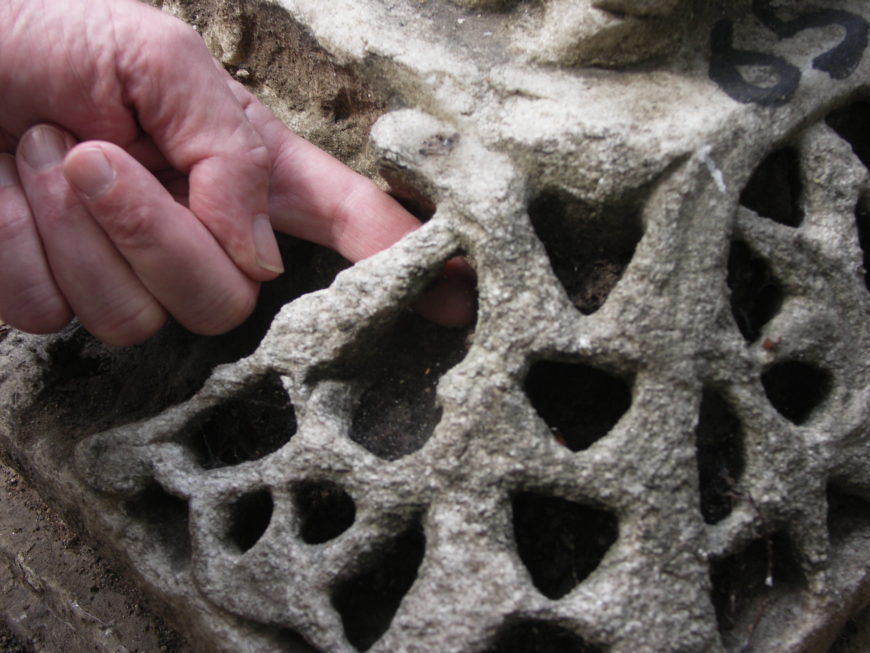
Deep Carving of Capital Fragment, Hagia Sophia (photo: William Allen, CC BY-NC-SA 2.0)
This deep carving appears throughout Hagia Sophia’s capitals, spandrels, and entablatures. Everywhere we look stone visually denying its ability to do the work that it must do. The important point is that the decoration suggests that something other than sound building technique must be at work in holding up the building.
A golden dome suspended from heaven
We know that the faithful attributed the structural success of Hagia Sophia to divine intervention. Nothing is more illustrative of the attitude than descriptions of the dome of Hagia Sophia. Procopius, biographer of the Emperor Justinian and author of a book on the buildings of Justinian is the first to assert that the dome hovered over the building by divine intervention.
…the huge spherical dome [makes] the structure exceptionally beautiful. Yet it seems not to rest upon solid masonry, but to cover the space with its golden dome suspended from Heaven.from “The Buildings” by Procopius, Loeb Classical Library, 1940, online at the University of Chicago Penelope project
The description became part of the lore of the great church and is repeated again and again over the centuries. A look at the base of the dome helps explain the descriptions.

Hagia Sophia Dome, Semi-Dome and Cherubim in the pendentive (photo: Steven Zucker, CC BY-NC-SA 2.0)
The windows at the bottom of the dome are closely spaced, visually asserting that the base of the dome is insubstantial and hardly touching the building itself. The building planners did more than squeeze the windows together, they also lined the jambs or sides of the windows with gold mosaic. As light hits the gold it bounces around the openings and eats away at the structure and makes room for the imagination to see a floating dome.
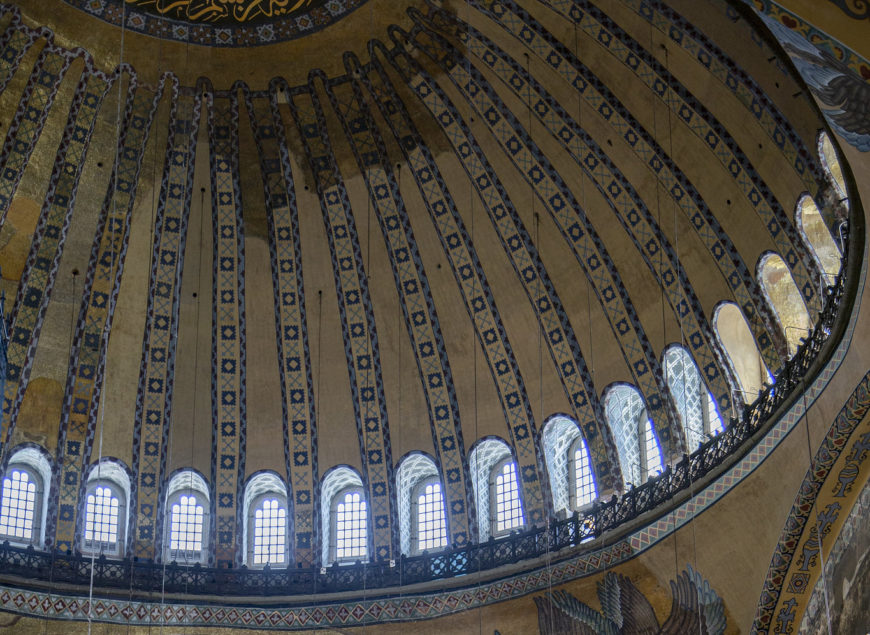
Windows at the Base of the Dome, Hagia Sophia (photo: byzantologist, CC BY-NC-SA 2.0)
It would be difficult not to accept the fabric as consciously constructed to present a building that is dematerialized by common constructional expectation. Perception outweighs clinical explanation. To the faithful of Constantinople and its visitors, the building used divine intervention to do what otherwise would appear to be impossible. Perception supplies its own explanation: the dome is suspended from heaven by an invisible chain.
Advice from an angel?
An old story about Hagia Sophia, a story that comes down in several versions, is a pointed explanation of the miracle of the church. So goes the story: A youngster was among the craftsmen doing the construction. Realizing a problem with continuing work, the crew left the church to seek help (some versions say they sought help from the Imperial Palace). The youngster was left to guard the tools while the workmen were away. A figure appeared inside the building and told the boy the solution to the problem and told the boy to go to the workmen with the solution. Reassuring the boy that he, the figure, would stay and guard the tools until the boy returned, the boy set off. The solution that the boy delivered was so ingenious that the assembled problem solvers realized that the mysterious figure was no ordinary man but a divine presence, likely an angel. The boy was sent away and was never allowed to return to the capital. Thus the divine presence had to remain inside the great church by virtue of his promise and presumably is still there. Any doubt about the steadfastness of Hagia Sophia could hardly stand in the face of the fact that a divine guardian watches over the church. [1]
Damage and repairs
Hagia Sophia sits astride an earthquake fault. The building was severely damaged by three quakes during its early history. Extensive repairs were required. Despite the repairs, one assumes that the city saw the survival of the church, amid city rubble, as yet another indication of divine guardianship of the church.
Extensive repair and restoration are ongoing in the modern period. We likely pride ourselves on the ability of modern engineering to compensate for daring 6th Century building technique. Both ages have their belief systems and we are understandably certain of the rightness of our modern approach to care of the great monument. But we must also know that we would be lesser if we did not contemplate with some admiration the structural belief system of the Byzantine Age.
Historical outline: Isidore and Anthemius replaced the original 4th-century church commissioned by Emperor Constantine and a 5th-century structure that was destroyed during the Nika revolt of 532. The present Hagia Sophia or the Church of Holy Wisdom became a mosque in 1453 following the conquest of Constantinople by the Ottomans under Sultan Mehmed II. In 1934, Atatürk, founder of Modern Turkey, converted the mosque into a museum.

